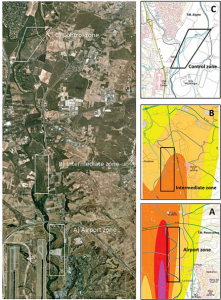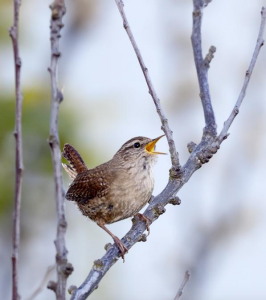Chances are you’ve woken up in the morning to the sounds of chirping birds. If you’re a very early riser, you may have even caught the “dawn chorus”, or the singing of a large number of birds before dawn each day. That is because songbirds (or Passerines) depend on vocal communication by way of songs and calls in order to transmit information over relatively large distances. Birdsong is one of the most complex animal languages— birds can jam a lot of information into their songs, altering pitch, intensity, and content to convey the desired signal to others. Predominantly, songs convey territorial declarations and reproductive readiness in the mating season.
However, one major constraint on this acoustic communication is environmental noise, which can mask or alter the songs, and therefore hamper information transfer. Think about how much harder it is to talk to or listen to someone in a noisy room versus in a quiet one. In some cases, where environmental noise exists but is not overbearing, birds reduce the impact of this superfluous noise by increasing the volume, or modifying the pitches of their songs. However, when the noise is so loud that birdsong modifications cannot improve the efficacy of perception by intended receivers, birds may also change their singing schedules in order to avoid or diminish any overlap with the external noise. One example of noise so loud that it doesn’t allow concurrent birdsong to be heard, is aircraft and air-traffic noise near major airports. Airports are also interesting because they have a highly predictable pattern, with air-traffic volume sharply increasing at 6AM.
In a study performed by Gil, Honarmand, Pascual, Perez-Mena, and Garcia, researchers hypothesized that birds living closest to airports, with the highest level of noise pollution, would modify their singing schedules to avoid periods of loud aircraft noise (Gil, et al., 2015). In order to test this hypothesis, the researchers used two different studies: single airport and multi-airport. In each of the two experiments they used automatic song recorders to collect song information starting three hours before dawn and ending two hours after dawn. In the first experiment they collected this information from three different locations, increasingly close to the Madrid Airport (Figure 2). The later experiment expanded the data collection to 5 different airports at different latitudes in order to tease apart the effect of dawn time and the effect of air-traffic noise. Or rather, to account for the arbitrary nature of human standard time compared to when the sun actually rises. The researchers predicted that birds advance their dawn choruses most at latitudes where astronomic dawn and human times are closest to each other.

Figure 2. Graphic of the three zones where bird songs were recorded. A is closest to the airport, with the highest amount of noise pollution, B is intermediate, and C is the control, furthest from airport with minimal noise pollution. Each zone was identical in species richness, and surrounded by similar habitats.
The researchers found that across a wide range of latitudes, bird populations sang their dawn chorus earlier. The extent to which they advanced their dawn choruses increased the closer meteorological dawn time and human standard times were to each other. For example, in the more Northern latitudes, where meteorological dawn occurs much earlier than “6 AM” when air-traffic starts, birds don’t need to advance their natural choruses nearly as much as those at more Southern latitudes where standard time is much closer to meteorological dawn do.
Similarly, bird species who normally sing closer to the time when aircraft traffic peaks, responded to aircraft noise pollution with a larger advance in their dawn chorus. Essentially, the more overlap between birds’ natural dawn chorus timing and human air-traffic mandates, the more birds advance their dawn choruses.
So, why should we care? Dawn choruses occur when the birds are physiologically prepared to commence their daily activities consisting of foraging and looking for a mate. Therefore, a bird that advances its singing time increases its metabolic rate and vigil, without necessarily increasing energy intake. Additionally, the longer birds sing in darkness (due to the advancement of their dawn choruses well before dawn) the more vulnerable they become to nocturnal predators.
It is interesting to consider what would happen if air-traffic became heavy at all times of day. Would airport zones subsequently become inhabitable for birds, or would birds evolve some sort of song modification that allowed them to compete with the airport noise. For now, we know what we’ve always been told– the early bird catches the worm.
References:
Gil, D., et al. (2015). Birds living near airports advance their dawn chorus and reduce overlap with aircraft noise. Behavioral Ecology, 26(2): 435-443.

